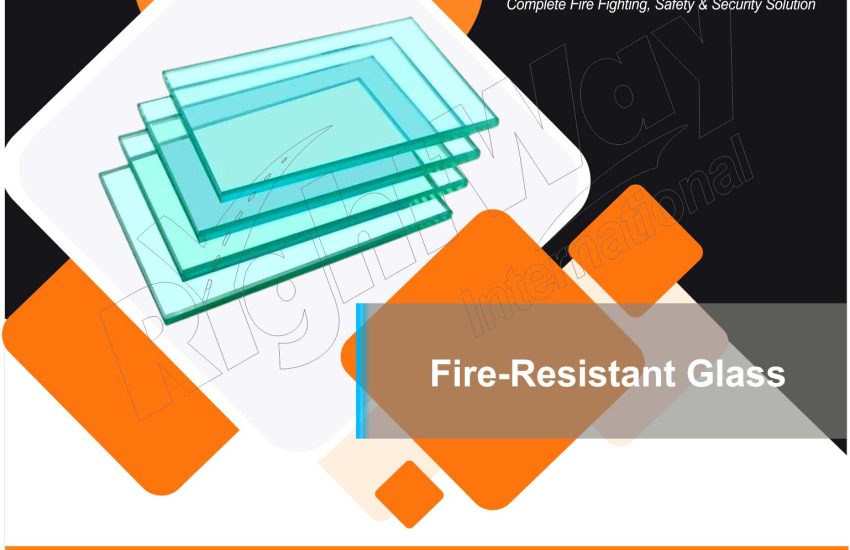Fire-Resistant Glass is a specialized type of designed to withstand the intense heat and flames of a fire, thereby preventing the spread of fire, smoke, and heat between different areas of a building. Its primary function is to maintain the integrity of fire-rated barriers, providing essential protection during emergencies. This article explores the different types of fire-resistant, their properties, applications, and benefits.
Types of Fire-Resistant Glass
- Tempered Glass with Fire-Resistant Coatings
- Description: This glass is heat-strengthened through a process of rapid heating and cooling, which increases its durability. A fire-resistant coating is then applied to enhance its performance under fire conditions.
- Applications: Suitable for internal partitions and areas requiring increased strength and some level of fire resistance.
- Laminated Glass with In-tumescent Inter-layers
- Description: Comprises multiple layers of glass with an inter-layer that expands when exposed to heat. This expansion forms an insulating barrier that slows down the heat transfer.
- Applications: Ideal for windows and doors in fire-rated settings, such as external facades and fire-resistant doors.
- Wire Glass
- Description: Contains a network of metal wires embedded within the glass, which helps to keep the glass intact during a fire and provides a barrier against flames and heat.
- Applications: Commonly used in fire doors and partitions where impact resistance is also a consideration.
- Fire-Resistant Glazing Systems
- Description: A comprehensive system involving layers of fire-resistant glass, in-tumescent materials, and specialized framing and sealing components designed to offer enhanced protection.
- Applications: Suitable for large-scale installations like curtain walls and glass facades where both transparency and fire resistance are required.
Properties of Fire-Resistant Glass
- Fire Rating
- Definition: The fire rating indicates how long the glass can endure fire before failing. It is measured in minutes (e.g., 30, 60, 90, or 120 minutes) and varies based on the type of fire-resistant glass.
- Thermal Insulation
- Description: Many fire-resistant glasses provide thermal insulation, helping to reduce the transfer of heat between areas.
- Impact Resistance
- Description: Certain types of fire-resistant glass are designed to withstand impact, preventing breakage and maintaining structural integrity during a fire.
- Optical Clarity
- Description: Fire-resistant glass can maintain high transparency, allowing natural light to pass through while still offering fire protection.
Applications of Fire-Resistant Glass
- Building Facades and Curtain Walls
- Fire-resistant is used in exterior walls to contain fires and prevent their spread between different parts of a building.
- Fire Doors and Partitions
- It is integral to the construction of fire-rated doors and partitions, helping to compartmentalize fire and smoke within buildings.
- Stairwells and Elevator Shafts
- Used in enclosures around stairwells and elevator shafts to ensure safe evacuation routes during a fire.
- Internal Glass Partitions
- Employed in office and commercial spaces to provide fire protection while maintaining an open and modern aesthetic.
Benefits of Fire-Resistant Glass
- Enhanced Safety
- Provides crucial protection against the spread of fire, aiding in safe evacuation and minimizing property damage.
- Compliance with Building Codes
- Essential for meeting building regulations and codes that require fire-resistant materials in specific areas.
- Aesthetic Flexibility
- Integrates seamlessly into building designs, offering both functional fire protection and aesthetic appeal.
- Increased Property Value
- Buildings with fire-resistant features often have higher market value due to enhanced safety and regulatory compliance.
Conclusion
Fire-resistant is an essential component in modern construction, offering a combination of safety, functionality, and design flexibility. By understanding the different types, properties, and applications of fire-resistant, architects, builders, and property owners can make informed choices that enhance safety and meet regulatory standards. Its role in preventing the spread of fire and maintaining structural integrity underscores its importance in creating safe and resilient buildings.


